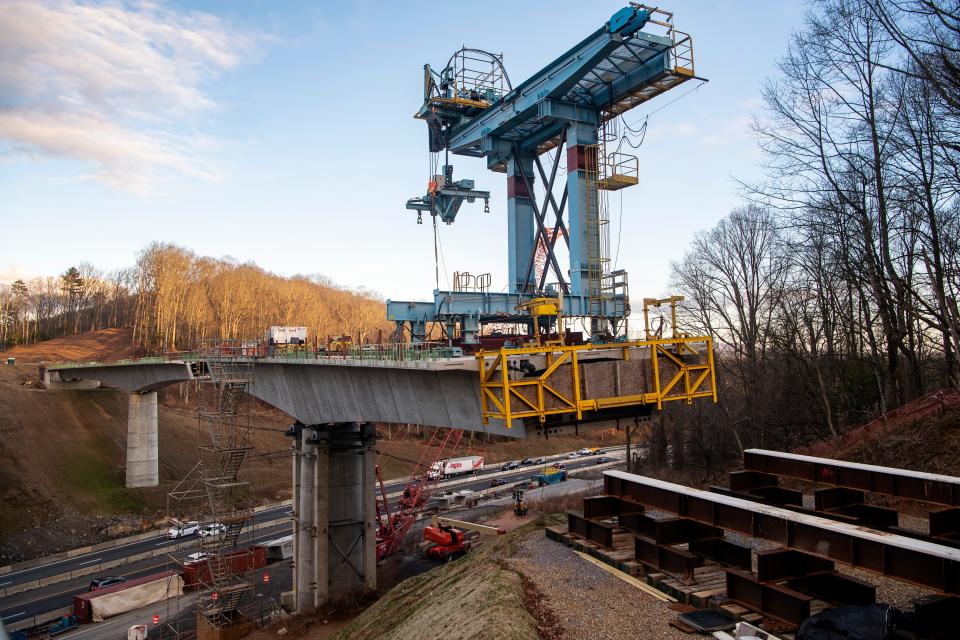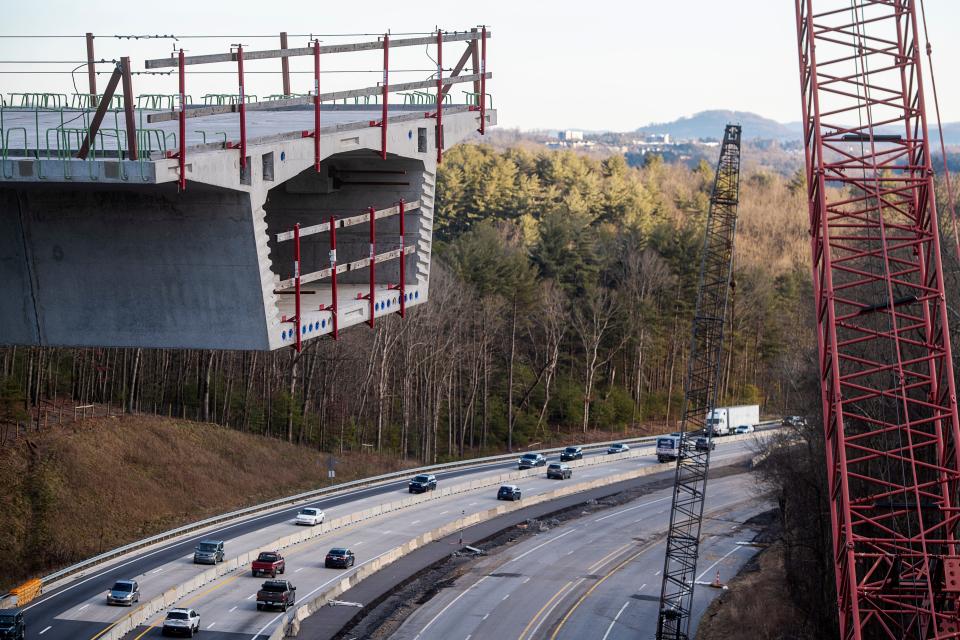Answer Man: Is unfinished Blue Ridge Parkway bridge over I-26 structurally sound?
ASHEVILLE - Today's burning question is about the engineering of the partially built Blue Ridge Parkway bridge over I-26. Got a question for Answer Man or Answer Woman? Email Executive Editor Karen Chávez at KChavez@citizentimes.com and your question could appear in an upcoming column.
Question: I'm wondering about that span of concrete bridge that is cantilevered out over the travel lanes of I-26. It has been hanging there seemingly unsupported for many months now and I'm wondering if you can shed light on the design and the plan to connect this bridge and also whether there is any concern about the tons and tons of concrete that seem to be hanging off in an unsupported way. Isn't there any concern about the strain that heavy load puts on the main support? I'm no structural engineer but it looks like it could not sustain that load indefinitely.
Answer: To be sure, the view of this towering bridge over I-26 in South Asheville is equal parts impressive and intimidating. If you are not a structure engineer, but rather a person viewing the incomplete structure with a novice's eye, it may indeed appear to hang precariously over the interstate, which, understandably enough, is an unsettling feeling.

But how a thing looks is not nearly as important as the soundness of its design. Rest assured, dear reader, the N.C. Department of Transportation, responsible for overseeing the project along with the Federal Highway Administration, keeps traveler safety at the top of its list of priorities.
“At no point and time has the travelling public on I-26 been in any danger from the new Blue Ridge Parkway bridge,” said Luke Middleton, resident engineer for the I-26 widening project in Buncombe County in an email.
Parkway visitors: Blue Ridge Parkway 2023 visits surged, Great Smokies also had crowds; How many visitors?
Middleton goes on to explain that the parkway bridge, near Milepost 391.8, south of the U.S. 25/Hendersonville Road access, uses a balanced cantilever method that is defined by having the same amount of weight on both sides of the pier, which it must have before construction can move forward.
“For example, one piece goes up on the east side of the pier, which is followed by a piece going up on the west side of the pier,” Middleton said in an email. “They go up in pairs, one piece at a time, and once a pair is up, the contractor runs permanent strands of rebar through the top of all of the pieces that are up at that point in time and stress them, pulling the pieces together.”

Additionally, Middleton said, the main piers, temporary towers, 1,000-ton jacks, rock anchors and counterweights are used to help balance the bridge pieces.
Why the cantilever method of construction versus an arch bridge or cable-stayed bridge? It seems the Federal Highway Administration preferred this segmental balanced cantilever method, Middleton said in his email to the Citizen Times.
The bridge project is being handled by the Maryland-based sub-contractor Structural Technologies VSL, which broke ground on the east side of the bridge first, completing that portion of the bridge last fall. The western portion of the bridge is more than halfway complete. Once it is finished, construction will begin on the middle section.
“What folks may casually call a keystone — the piece in the middle — will be the only section that is poured on site,” Middleton said in an email to the Citizen Times.

The $14.5 million project to replace the existing bridge is considered a necessary measure to accommodate the road-widening to the interstate below. It could take up to six months before all segmental construction is finished, Middleton said, with barrier wall, overlaying the deck, pouring approach slabs and various other bits and pieces left to check off the list before the bridge is open to traffic, which should happen sometime later this year.
For its part, the National Park Service is working with the agencies building the bridge, noting that that entails clearing existing forest and significant earth moving. "It gives us a small glimpse into conditions similar to what it would have been like during the original construction of the entire 469-mile Parkway route," parkway spokesperson Leesa Brandon wrote the Citizen Times in an email.
Answer Man: What's being built on South Bear Creek Road? Trees being removed?
Asheville Answer Man: Is the Hyatt Place near airport to open soon? Under construction forever?
Aaron Nelsen is the trending news editor for the Asheville Citizen Times. His past stops include the San Antonio Express-News, where he was the Rio Grande Valley bureau chief, and for Time Magazine in Chile. Reach him at anelsen@citizentimes.com or follow him on twitter @amnelsen.
This article originally appeared on Asheville Citizen Times: Blue Ridge Parkway bridge safe for Interstate-26 traffic?

